El Capitan - Nose Attempt
September 14-16
Tom Rogers, Eric Zann and I hatched a plan to climb The Nose on El Cap, so with 8 full days in the Valley ahead of us, we flew down to Oakland and drove towards the park. We'd stopped at Trader Joe's for food and Safeway for water bottles. By the time we were done the car was filled to the brim and we were stuck in evening traffic out of the Bay.
We arrived in the valley under a full moon with El Cap bathed in enough light to get our pulses going In an unbelievable place to climb, we were here to climb the prize. Or so we hoped.
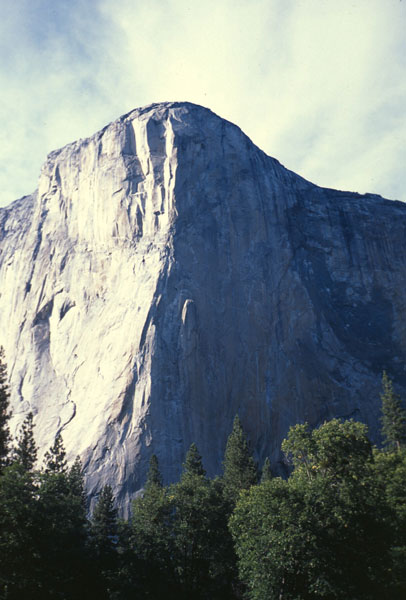
El Capitan. The Nose follows the line between light and dark.
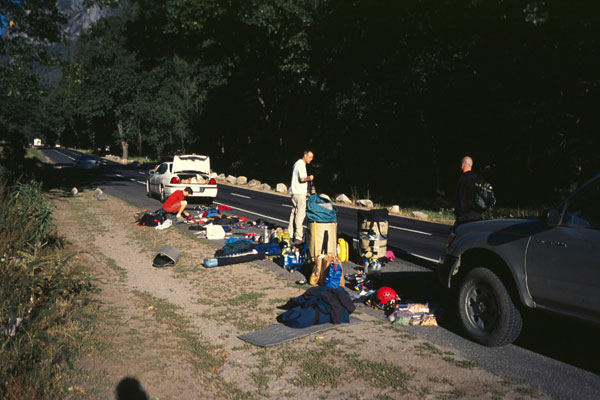
Gearing up for the Nose. Wow that's a lot of stuff.
The next day we got up early and started packing and packing, eventually carrying many loads to the base of the route. We had carried everything up to the ledge below "Pine Line" on the left side of the buttress, and packed the bags there. This turned out to be big mistake #1. The bags were packed full and bulky things like sleeping bags didn't fit inside. Meanwhile, Eric had scrambled up the 4th class way, and dropped a line down to us and the bags. Around 2pm I set off up the line with Eric close behind. We established an anchor below the first real pitch and tried to haul the bags, all at once, up the gulley. Needless to say, we couldn't even budge the near 200 lb load. After some swearing a good deal and looking at our options, I suggested we just climb up to Sickle Ledge and try and haul up the fixed lines route. Eric went down to talk to Tom, and I decided that I'd solo the first pitch to keep us moving up the route.
The first pitch starts up a wide crack in an awkward shallow corner. I aided on up, realizing exactly why Aliens had been invented. The pin scarring was extreme and the narrow profile of the alien was about the only thing that would fit. I also realized, with a bit of hesitation, that we had brought only 3 of them. I knew that to keep the SuperTopo's Clean aid ratings realistic, it required a full quiver of modern gear. I decided to live by the mantra of "No Alien shall be left behind."
After some reachy top steps, and a couple of bolts there is a short free section that leads through thin (C1+) cracks up to the belay ledge. I fixed both lines and waited, unsure as to if we were going to try and lead another pitch today, or what. I decided to just relax, take in the evening sun on this high perch and watch Tom and Eric complete what looked like some of the most painful hauling in the Valley. That night we got the both bags up to the top of the first real pitch before heading back to Curry for pizza.
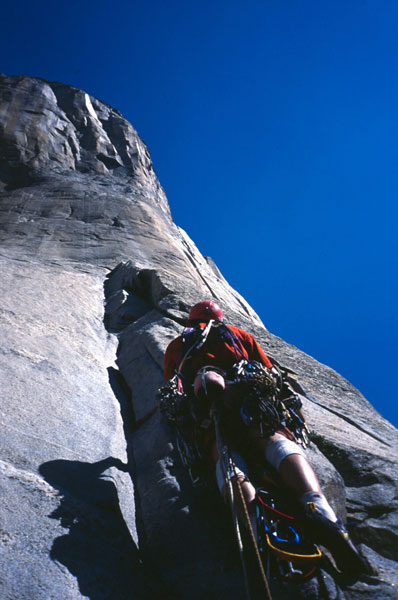
Eric leading off on pitch 2.
The next day we began with a not so early start, but with a plan to climb and haul everything up at least to Sickle Ledge. Eric and I regained our high point while Tom packed the 'floating' gear into our third haulsack: an army duffel bag. Eric free climbed off the belay until the corner thinned out and he was able to pendulum over to the next crack. The pitch went quick, but the hauling was slow. Because it took two people to haul even one of our bags, we couldn't really take advantage of 3-person wall technique where someone is always leading. In fact, because the bags generally needed to be lowered out, the follower person would have to wait until the last bag was being hauled before he could begin to clean the pitch.
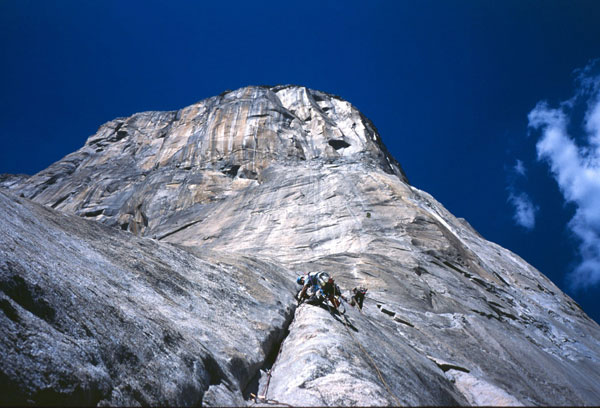
Tom leading the crux (3rd) aid pitch with a loooong way to go still.
We continued in this fashion, swinging leads until at around 7 pm when Eric reached Sickle Ledge. This pitch had a huge lower-out, at least 100 ft, and a rope-eating flake right in the middle of it. Having 30 minutes of daylight left, a crappy bivi for 3 on Sickle, and a portaledge along, Tom and I decided to bivi on top of pitch 3, while Eric would sleep on the ledge.
As Tom and I readied ourselves for the night, we grabbed a food bag and clipped it off, deciding that whatever it held would be dinner. Sure enough, the anchors weren't quite far enough away from a small corner (who the hell bivi's here anyways??) so the portaledge was extremely tippy all night long. Finally though, we were all settled in and ready to eat. Eagerly I popped open the stuff sack of food but to my great disappointment, it contained several bags of rotting, sour vegetables. However, at the bottom of the bag there happened to be a bag of gummy bears. So that night (and next morning) we ate gummy bears.
The next morning Tom and I hauled and climbed up to the Sickle where Eric had spent a cramped night with two other Italians. We re-evaluated our situation, and I decided to go down with about 70 lbs of gear and two haul sacks, hopefully giving Tom and Eric enough of a boost that they could fire off the rest of the route. A painful (for my back) ride down the fixed lines soon brought me to the ground. Unfortunately, after climbing for the rest of the day, Eric and Tom decided they were still moving too slow. They bailed off, rappelling down the route through the night.
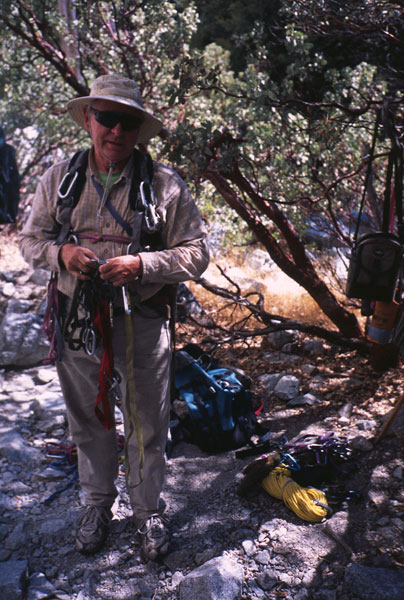
The "Mad Bolter" was at the base to greet me when I came down.
He has established achors such that you can rappell easily to the ground
from any point on the Nose. And they were all drilled by hand.
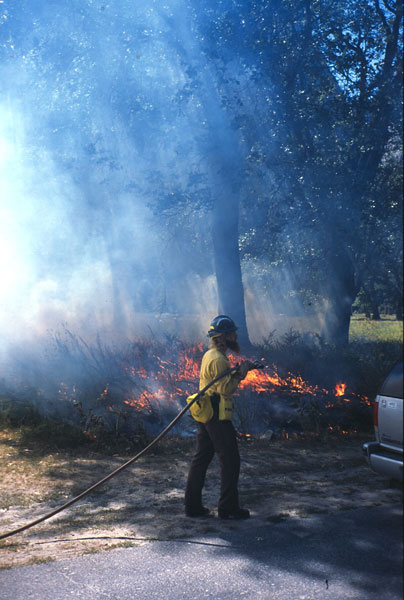
A controlled fire burning in the Meadow that had looked so cool at night
from up above.
As many people don't succeed on their first grade VI, I wasn't too disappointed. I think the lessons I learned will help me succeed next time. Some of those are:
- You should be practicing and climbing with your partners a ton. If not, you will have no idea as to how efficient you'll be on the wall, and what each other's motivation will be. As wall climbing is more like work than climbing, staying motivated seems to be key.
- Pack the haulbag carefully! Don't throw in everything and the kitchen sink, just because you'll be hauling it. Pack precisely BECAUSE you'll be hauling it. Ideally, you (or both of you at first) should be able to haul everything in one shot. When I descended and looked at what I had come down with, among other things I found that we'd each individually packed lots of extra batteries, totaling at least 3 or 4 pounds of unnecessary weight.
- For an inexperienced party, two people is faster than three. There is less weight to carry, fewer ropes, and less gear.
- Know how much water you will need. Is it a gallon per person per day? Three or even two quarts? Will your consumption increase or decrease as you go up the wall? This is different for each person, so you and your partner could bring different amounts.
- Carry some food for the day on your harness, otherwise you won't eat until you dig into the haulbags at night.
- Bring enough of the proper gear. Some of the pitches low on The Nose used to be A3. Obviously modern gear has eased that, but make sure you have that modern gear!
- Aid climb in your rock shoes if the terrain at all dictates free climbing. This allows you to pull free moves when you can, climb past really poor aid placements, and not freak out when you have mandatory slab climbing in wall boots. For instance, the 4th pitch of The Nose starts at 5.9 up a slabby corner, or alternatively it can be C2 on insecure tiny offset nuts. It might take you 5 minutes to free (or french-free) the section and 30 minutes to aid it.
- Be willing to suffer for many days. As others have stated, "No one ever said wall climbing was supposed to be fun!" Then again, if you can climb without hauling, that changes everything.